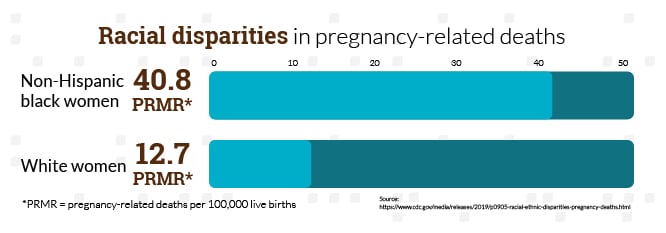It’s important to build a diverse workforce that provides equitable care to all patients. Patients need to know that their voices are being represented by healthcare professionals of different races and cultures so that they can receive better care — and achieve better outcomes.
Social factors can greatly impact the experience a person has with their healthcare provider and care team. Not everyone has equal access to healthcare. And not everyone benefits equally from the access they do have.
That’s why we’re committed to building a diverse workforce — it’s an essential part of providing equitable care. We’re looking for professionals who share this commitment and will help build an inclusive work environment to pave the way for better healthcare.
Workplace diversity in healthcare
We want to create a supportive workplace for our providers and care team members. That means working hard to understand the nuances of their relationships with our members.

For example: Let’s consider the following situation. A nursing assistant with a slight Somalian accent is providing skilled care for a population of mostly elderly white people. If the nursing assistant experiences hostility or difficulty connecting with those patients, she’ll need support from a diverse team that truly understands what she and her patients are going through.
Inclusion and conversation go hand in hand. Open communication leads to better support of our providers and better care for our members — the healing environment that we all want and all deserve.
Why are diversity and inclusion so important to Vera?
In a conversation with Medical Director Dr. Sarat Raman, he shared this: “If you are African American, you are statistically less likely to be screened for colon cancer. But you’re also more likely to have it and more likely to die from it than a non-Hispanic white person is. It doesn’t matter if you are the King of Wakanda. Race is one of the social determinants that affects a person’s ability to be healthy, live a long life, and achieve good outcomes from any diseases they have.”

A social determinant of health is a factor that impacts a person’s health, but isn’t intrinsic to the person themself. Weight or family history of diabetes, for example, aren’t social determinants of health. Things like income, class, sex, and race are.
Why? Because these are external pressures that can affect the quality and availability of the healthcare available to someone and, as a result, their health outcomes.
We’re committed to building a diverse workforce that provides equitable care. In the words of Dr. Raman, “We need our staff to be as representative of our population as it can be. Patients need to know that their voices are being represented by people who are similar to them, whether that is by gender, by race, or by culture.”
Health access and implicit bias
What causes race-driven disparities in healthcare? Sometimes it’s a question of access. People who live in communities of color might be less likely to have health services nearby. They’re less likely to have jobs that provide health insurance or to have income that allows them to see the doctor.

In some cases, implicit bias of a provider plays a role. Racism, along with sexism and classism, can have a host of insidious contributions.
A resource (like access to a primary care center) may seem equally available to everyone. But implicit bias can prevent some people from obtaining full access to that resource. Medical studies have shown that racial and ethnic minorities are subject to less accurate diagnoses, curtailed treatment options, less pain management, and worse clinical outcomes.
It’s important for us as health providers to be aware of implicit biases that aren’t easy to recognize within ourselves.
“Healthcare is just as prone to systemic racism as any other field,” said Dr. Raman.
How exclusion can impact health
Factors like access and implicit bias seem fairly straightforward, but they don’t explain every disparity.
For example, even when economic and educational status are taken into account, pregnancy and birth outcomes for African American women are much more likely to be adverse than outcomes for non-African American women. A Harvard-educated lawyer who is African American is still more likely than her white classmate to experience an early premature delivery, severe maternal morbidity, or the death of an infant.

Researchers and health providers are still learning about the different ways that race can act as a social determinant of health. Research by Professor Arline Geronimus at the University of Michigan indicates that African American people may actually experience faster average gene degradation than white populations, as a result of generations of systemic racism: violence, discrimination, and microaggressions.
Dr. Raman had this to add: “Maybe equity is … recognizing that the outcome has to be equal. And for that to happen, we need to have a different process for different people based on different factors: race, gender, culture, or geography. We have to become a little bit more aware of people’s individual needs.”
Social determinants of health can have complex effects. As we continue to learn about how race intersects with health, Vera will keep pursuing our goal of a diverse and inclusive workforce that provides truly equitable care.
Our practical approach to equitable care
At Vera, we measure authenticity by action. Through internal structure, education, and training, we want to reflect and understand the populations we serve. From leadership to every individual employee, Vera is dedicated to making racial equity a priority for members and providers.
One of our main priorities is making sure we collect reliable information directly from patients about their race, ethnicity, and preferred language.
Data as simple as addresses and zip codes can also say a lot about a patient’s average life expectancy, level of socioeconomic stress, and other factors. By examining demographic data, we get a clearer picture of health disparities and are better equipped to solve for them.
We’re asking our employees, too. Our newly established RISE Committee, comprised of individuals from across the organization and self-identifying diverse demographics, is focused on using census data to guide short-term and long-term goals for Vera to better support more diverse, inclusive, and equitable practices in healthcare.
Do you want to join a team that is passionate about overcoming health inequity? Explore our open positions and apply today!
Sign up
Join our email list to receive the latest open positions, Vera Careers news, and more.





